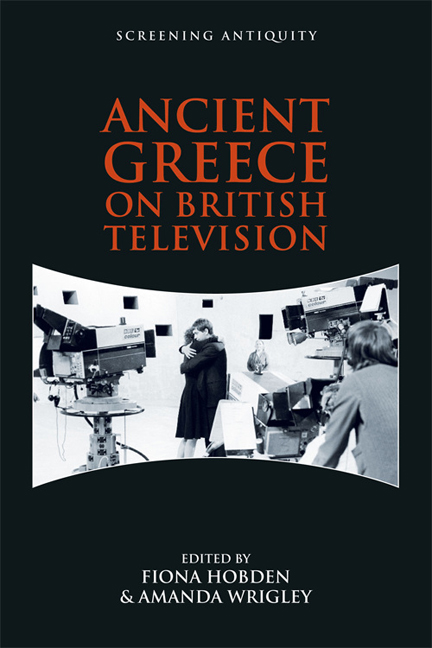Book contents
- Frontmatter
- Contents
- List of Figures and Tables
- Series Editors’ Preface
- Acknowledgements
- Contributors
- Abbreviations
- Broadcasting Greece: An Introduction to Greek Antiquity on the Small Screen
- 1 Are We the Greeks? Understanding Antiquity and Ourselves in Television Documentaries
- 2 Louis MacNeice and ‘The Paragons of Hellas’: Ancient Greece as Radio Propaganda
- 3 The Beginnings of Civilisation: Television Travels to Greece with Mortimer Wheeler and Compton Mackenzie
- 4 Tragedy for Teens: Ancient Greek Tragedy on BBC and ITV Schools Television in the 1960s
- 5 The Serpent Son (1979): A Science Fiction Aesthetic?
- 6 Don Taylor, the ‘Old-Fashioned Populist’? The Theban Plays (1986) and Iphigenia at Aulis (1990): Production Choices and Audience Responses
- 7 The Odyssey in the ‘Broom Cupboard’: Ulysses 31 and Odysseus: The Greatest Hero of Them All on Children’s BBC, 1985–1986
- 8 Greek Myth in the Whoniverse
- 9 The Digital Aesthetic in ‘Atlantis: The Evidence’ (2010)
- 10 Greece in the Making: From Intention to Practicalities in Television Documentaries. A Conversation with Michael Scott and David Wilson
- Bibliography
- Index
9 - The Digital Aesthetic in ‘Atlantis: The Evidence’ (2010)
Published online by Cambridge University Press: 24 April 2021
- Frontmatter
- Contents
- List of Figures and Tables
- Series Editors’ Preface
- Acknowledgements
- Contributors
- Abbreviations
- Broadcasting Greece: An Introduction to Greek Antiquity on the Small Screen
- 1 Are We the Greeks? Understanding Antiquity and Ourselves in Television Documentaries
- 2 Louis MacNeice and ‘The Paragons of Hellas’: Ancient Greece as Radio Propaganda
- 3 The Beginnings of Civilisation: Television Travels to Greece with Mortimer Wheeler and Compton Mackenzie
- 4 Tragedy for Teens: Ancient Greek Tragedy on BBC and ITV Schools Television in the 1960s
- 5 The Serpent Son (1979): A Science Fiction Aesthetic?
- 6 Don Taylor, the ‘Old-Fashioned Populist’? The Theban Plays (1986) and Iphigenia at Aulis (1990): Production Choices and Audience Responses
- 7 The Odyssey in the ‘Broom Cupboard’: Ulysses 31 and Odysseus: The Greatest Hero of Them All on Children’s BBC, 1985–1986
- 8 Greek Myth in the Whoniverse
- 9 The Digital Aesthetic in ‘Atlantis: The Evidence’ (2010)
- 10 Greece in the Making: From Intention to Practicalities in Television Documentaries. A Conversation with Michael Scott and David Wilson
- Bibliography
- Index
Summary
Over the many centuries since the Greek philosopher Plato committed it to writing, the story of Atlantis, the city destroyed by Poseidon, god of the sea, has captured people's imagination. From the treatises of renowned thinkers to the jingoistic discourses of nation states to the explorations of adventure archaeologists, two questions in particular recur: did Atlantis exist, and where was it? On 2 June 2010, ‘Atlantis: The Evidence’ (henceforth ‘Atlantis’), an episode of the BBC2 historical documentary Timewatch series, set out to investigate. As the title suggests, the aim was to gather and evaluate clues: these were to reveal that the Platonic myth referred to the Bronze Age town of Thera, which was destroyed during a massive volcanic eruption towards the end of the second millennium BC. This theory was hardly new. However, in the use of digital technology in the assemblage and display of evidence, ‘Atlantis’ built a distinctive account of Atlantis- Thera before, during and after the eruption. In this, the programme conformed to the emerging digital aesthetics of historical documentaries on television. However, the scale and diversity of digital tools used for visualisation make ‘Atlantis’ an illuminating case study not only for the treatment of an ancient Greek myth on British television, but for the impact of digital technologies in the documentary genre.
Across the creative industries, digital tools have become ubiquitous in the production of audiovisual images, especially through CGI, by which means environments and their inhabitants – and therefore historical places and people – can be produced. At the same time, academics today use digital technologies to visualise places distant in time and space via interactive mapping, 3D models and prototypes: techniques that are frequently described as ‘cyber-archaeology’. In both cases, digital tools offer new opportunities for representing the past, mimetically and schematically. The application may be for entertainment or for education, or both, but always the result is constructive of the past. So, for example, video games are increasingly analysed as forms of (hi)storytelling, by which players navigate landscapes and engage with narratives that immerse them in, and thereby develop a sense of, the past.
- Type
- Chapter
- Information
- Ancient Greece on British Television , pp. 187 - 202Publisher: Edinburgh University PressPrint publication year: 2018

